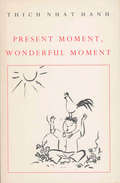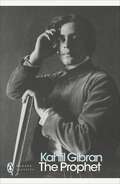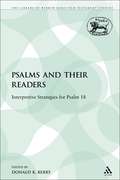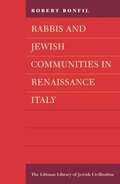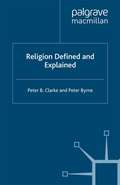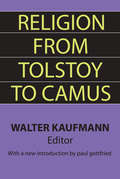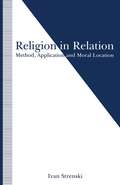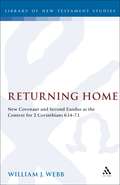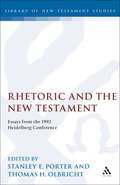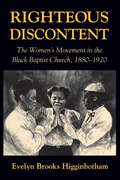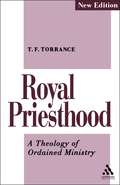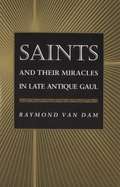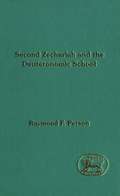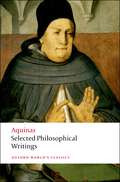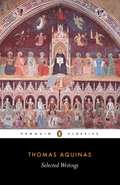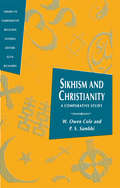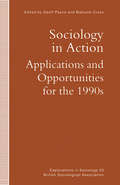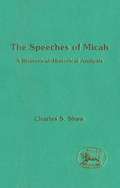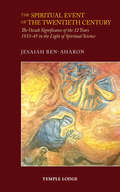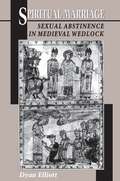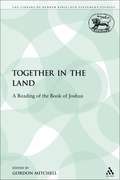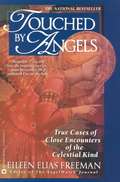- Table View
- List View
Present Moment, Wonderful Moment: Mindfulness Verses For Daily Living (Buddhism Ser.)
by Thich Nhat HanhPresent Moment, Wonderful Moment contains a wide range of short, evocative verses which we can use as meditations as we go about our daily affairs. Each verse is accompanied by a commentary, and the themes that are explored include: smiling at you anger; opening the window; getting dressed; serving food; greeting someone; washing vegetables; watering the garden and driving the car. Thich Nhat Hanh provides a perfect aid to mediation whatever you are during the day.
The Prophet: Penguin Classics (Penguin Modern Classics)
by Robin Waterfield Khalil GibranFirst published in the 1920's, THE PROPHET an inspirational, allegorical guide to living, the book is perhaps the most famous work of religious fiction of the Twentieth Century and has sold millions of copies in more than twenty languages. Gibran'sprotagonist, called simply 'the Prophet', delivers spiritual, yet practical, homilies on a wide variety of topics central to daily life: love, marriage and children; work and play; possessions, beauty, truth, joy and sorrow, death and many many more.
The Psalms and their Readers: Interpretive Strategies for Psalm 18 (The Library of Hebrew Bible/Old Testament Studies)
by Donald K. BerryA reader-oriented approach provides a substantially new angle of vision on Psalm 18 and Psalms study in general. Reader-based interpretation is compared to conventional methodologies by means of four separate analyses of Psalm 18: a textual study, a form-critical explication, a rhetorical study, and an experimental reader-oriented study involving the following strategies. Initially, the components of the text are considered as networks of signals for the reader. Secondly, the text's speech acts are isolated and typified. Thirdly, the ancient and contemporary contexts for the reading of the psalm are examined. The reader-oriented study culminates in two perspectives upon Psalm 18. The psalm may be read as a ritual speech act performed by the community of ancient worshippers, or as a lyric poem that each contemporary reader experiences by identification with the speaker. The concluding chapter reviews each of the methodologies, evaluating strengths and weaknesses, as well as interrelationships among methods.
Rabbis and Jewish Communities in Renaissance Italy (The Littman Library of Jewish Civilization)
by Robert BonfilFocusing on the figure of the rabbi, this book provides a vivid picture of Italian Jewry during the Renaissance. The author discusses Jewish life of the period (c.1450–1600) in its social, institutional, and cultural aspects, placing them against the backdrop of the wider Catholic environment to give an original interpretation of how Jewish cultural and religious life developed in the Renaissance context. Particular attention is given to changes in the status and functions of the rabbis and to the relations between the rabbinate and the lay leadership. Of special interest is the exploration of the cultural world of the rabbis and the broader issue of intellectual developments at the time. Essentially a translation of Part I of the Hebrew edition, which won wide acclaim for its perspective, Rabbis and Jewish Communities in Renaissance Italy has been carefully adapted for an English-speaking readership. Substantial excerpts from the appendices have been incorporated into the text so that the evidence necessary to support the arguments is easily accessible.
Religion Defined and Explained
by P. Clarke P. Byrne Scotney EvansThis book examines a selection of major types of theory explaining religion: religious, philosophical, sociological, socio-economic and psychological. It treats of the presuppositions behind such theories and the grounds of their necessity and validity. It looks at major styles in the definition of religion. It argues that the case for making religion the subject of large scale theorising has not been made and contends that the explanation of religion proceeds better by concentrating on the specifics of religious history and the interconnections between religious ideas.
Religion from Tolstoy to Camus
by Walter KaufmannWalter Kaufmann devoted his life to exploring the religious implications of literary and philosophical texts. Deeply skeptical about the human and moral benets of modern secularism, he also criticized the quest for certainty pursued through dogma. Kaufmann saw a risk of loss of authenticity in what he described as unjustied retreats into the past. This is a compilation of signicant texts on religious thought that he selected and introduced.
Religion from Tolstoy to Camus
by Walter Kaufmann Paul GottfriedWalter Kaufmann devoted his life to exploring the religious implications of literary and philosophical texts. Deeply skeptical about the human and moral benets of modern secularism, he also criticized the quest for certainty pursued through dogma. Kaufmann saw a risk of loss of authenticity in what he described as unjustied retreats into the past. This is a compilation of signicant texts on religious thought that he selected and introduced.
Religion in Relation: Method, Application and Moral Location
by Ivan StrenskiIn this collection of 11 essays the author outlines a programme of integrative, contextualized studies of religion. A number of different themes are included in these modern studies of religion.
Returning Home: New Covenant and Second Exodus as the Context for 2 Corinthians 6.14-7.1 (The Library of New Testament Studies #85)
by William WebbThe text of 2 Cor. 6.14-7.1, commonly called the 'fragment', has been the focus of much debate, due largely to its enigmatic presence within the context of 2.14-7.4. This work forges a new line of research on the problem of contextual disruption through an examination of the Old Testament traditions used within the fragment (their source, redactional focus and theology). Next, a similar traditions study is pursued in the current literary context of 2.14-7.4. A surprising degree of continuity between the fragment and its context is discovered in the use of Old Testament traditions, particularly those relating to new covenant and second exodus (exilic return) traditions. From this investigation a contextual hypothesis is proposed, along with a critique of competing contextual theories. The book concludes with two appendices which apply the contextual hypothesis to the crucial interpretative issue in 6.14a. Although the author's contextual hypothesis is not dependent upon any one interpretative solution in 6.14a, it nonetheless offers some fresh insight into the questions of who the 'unbelievers' are and what the 'unequal yoke' is.
Rhetoric and the New Testament: Essays from the 1992 Heidelberg Conference (The Library of New Testament Studies)
by Stanley E. Porter Thomas H. OlbrichtWhat role did classical rhetoric play in the writing of the New Testament? What role does classical and modern rhetoric play in interpreting the New Testament today? What role should classical and modern rhetoric play in New Testament interpretation? These and related questions are asked in this collection of over twenty essays originally delivered as papers at the 1992 Heidelberg Conference on Rhetorical Criticism of Biblical Documents. This conference, the first of several scheduled to address fundamental rhetorical issues of increasing importance in New Testament study, drew scholars from three continents and over fourteen countries, making it a truly international scholarly event and this a truly cosmopolitan publication. The authors' varying contexts resulted in a lively and challenging discussion well reflected in this volume's essays. The first part discusses rhetoric in the light of extended interpretation of a variety of New Testament texts. Luke and Acts, most of Paul's letters, and other New Testament documents are scrutinized using various rhetorical categories. In the second part, questions of rhetoric and methodology are raised. New approaches are tested in a number of essays that push the boundaries of traditional rhetorical study. These essays provide an excellent sampling of some of the major work being done in rhetorical study of the New Testament and suggest several avenues for future research.
Righteous Discontent: The Women’s Movement in the Black Baptist Church, 1880–1920
by Evelyn Brooks HigginbothamWhat Du Bois noted has gone largely unstudied until now. In this book, Evelyn Brooks Higginbotham gives us our first full account of the crucial role of black women in making the church a powerful institution for social and political change in the black community. Between 1880 and 1920, the black church served as the most effective vehicle by which men and women alike, pushed down by racism and poverty, regrouped and rallied against emotional and physical defeat. Focusing on the National Baptist Convention, the largest religious movement among black Americans, Higginbotham shows us how women were largely responsible for making the church a force for self-help in the black community. In her account, we see how the efforts of women enabled the church to build schools, provide food and clothing to the poor, and offer a host of social welfare services. And we observe the challenges of black women to patriarchal theology. Class, race, and gender dynamics continually interact in Higginbotham’s nuanced history. She depicts the cooperation, tension, and negotiation that characterized the relationship between men and women church leaders as well as the interaction of southern black and northern white women’s groups. Higginbotham’s history is at once tough-minded and engaging. It portrays the lives of individuals within this movement as lucidly as it delineates feminist thinking and racial politics. She addresses the role of black Baptist women in contesting racism and sexism through a “politics of respectability” and in demanding civil rights, voting rights, equal employment, and educational opportunities. Righteous Discontent finally assigns women their rightful place in the story of political and social activism in the black church. It is central to an understanding of African American social and cultural life and a critical chapter in the history of religion in America.
Royal Priesthood: A Theology of Ordained Ministry
by Thomas F. TorranceAn up-to-date ecumenical understanding of the Church and its ministry that cuts across divisions between Catholic and Evangelical, Anglican and Reformed, and includes the ministry of both men and women.
Saints and Their Miracles in Late Antique Gaul
by Raymond Van DamSaints' cults, with their focus on miraculous healings and pilgrimages, were not only a distinctive feature of Christian religion in fifth-and sixth-century Gaul but also a vital force in political and social life. Here Raymond Van Dam uses accounts of miracles performed by SS. Martin, Julian, and Hilary to provide a vivid and comprehensive depiction of some of the most influential saints' cults. Viewed within the context of ongoing tensions between paganism and Christianity and between Frankish kings and bishops, these cults tell much about the struggle for authority, the forming of communities, and the concept of sin and redemption in late Roman Gaul.Van Dam begins by describing the origins of the three cults, and discusses the career of Bishop Gregory of Tours, who benefited from the support of various patron saints and in turn promoted their cults. He then treats the political and religious dimensions of healing miracles--including their relation to Catholic theology and their use by bishops to challenge royal authority--and of pilgrimages to saints' shrines. The miracle stories, collected mainly by Gregory of Tours, appear in their first complete English translations.
Saints and Their Miracles in Late Antique Gaul
by Raymond Van DamSaints' cults, with their focus on miraculous healings and pilgrimages, were not only a distinctive feature of Christian religion in fifth-and sixth-century Gaul but also a vital force in political and social life. Here Raymond Van Dam uses accounts of miracles performed by SS. Martin, Julian, and Hilary to provide a vivid and comprehensive depiction of some of the most influential saints' cults. Viewed within the context of ongoing tensions between paganism and Christianity and between Frankish kings and bishops, these cults tell much about the struggle for authority, the forming of communities, and the concept of sin and redemption in late Roman Gaul.Van Dam begins by describing the origins of the three cults, and discusses the career of Bishop Gregory of Tours, who benefited from the support of various patron saints and in turn promoted their cults. He then treats the political and religious dimensions of healing miracles--including their relation to Catholic theology and their use by bishops to challenge royal authority--and of pilgrimages to saints' shrines. The miracle stories, collected mainly by Gregory of Tours, appear in their first complete English translations.
Second Zechariah and the Deuteronomic School (The Library of Hebrew Bible/Old Testament Studies)
by Raymond F. Person Jr.Person concludes that the Deuteronomic school's redactional activity continued into the postexilic period. In Part I, he first critiques the commonly-held conclusion that the Deuteronomic school ceased in the Exile. He then presents evidence that suggests that the Deuteronomic redactions of the Deuteronomic History and Jeremiah continued into the postexilic period. this evidence is of two types: (1) Deuteronomic phraseology in the postexilic additions found in the MT and (2) the themes of return and restoratin as vaticinia ex eventu. In Part II, the conclusion that the Detueronomic school continued in the postexilic period is bolstered with additional evidence in the form of Deuteronomic phraseology in the redactional material of Second Zechariah. adapting the methodology applied by J Philip Hyatt and others to Jeremiah, Person argues that Zechariah was redacted by the Deuteronomic school with the addition of the Deuteronomic prose in Zechariah 9-14. In Part III, Person comments on the possible social setting of the Deuteronomic school in postexilic Yehud as well as its theology in this setting.
Selected Philosophical Writings (Oxford World's Classics)
by Thomas AquinasSt Thomas Aquinas (1225-1274) saw religion as part of the natural human propensity to worship. His ability to recognize the naturalness of this phenomenon and simultaneously to go beyond it, to explore spiritual revelation, makes his work fresh and highly readable today. While drawing on a strong distinction between theology and philosophy, Aquinas interleaved them intricately in his writings, which range from an examination of the structures of thought to the concept of God as the end of all things. This accessible new translation chooses substantial passages not only from the indispensable Summa Theologicae, but from many other works, fully illustrating the breadth and progression of Aquinas's philosophy. ABOUT THE SERIES: For over 100 years Oxford World's Classics has made available the widest range of literature from around the globe. Each affordable volume reflects Oxford's commitment to scholarship, providing the most accurate text plus a wealth of other valuable features, including expert introductions by leading authorities, helpful notes to clarify the text, up-to-date bibliographies for further study, and much more.
Selected Writings: Selected Writings (Classics Of Western Spirituality Ser. #No.60)
by Thomas AquinasIn his reflections on Christianity, Saint Thomas Aquinas forged a unique synthesis of ancient philosophy and medieval theology. Preoccupied with the relationship between faith and reason, he was influenced both by Aristotle's rational world view and by the powerful belief that wisdom and truth can ultimately only be reached through divine revelation. Thomas's writings, which contain highly influential statements of fundamental Christian doctrine, as well as observations on topics as diverse as political science, anti-Semitism and heresy, demonstrate the great range of his intellect and place him firmly among the greatest medieval philosophers.
Sikhism and Christianity: A Comparative Study (Themes in Comparative Religion)
by W.O. Cole Piara Singh SambhiThis volume will provide a thorough comparison of the rituals, beliefs and history of Sikhism and Christianity. Chapters will focus on God, revelation, the scriptures, worship, ethics and the history of these two religions, and will highlight both differences and similarities.
Sociology in Action: Applications and Opportunities for the 1990s (Explorations in Sociology.)
by Malcolm Cross Geoff PayneIn the last decade of this century, sociology has grown into a major contributor to public debate and social policy. After a period of introspection and uncertainty, sociologists are becoming more self-confident about their subject's potential to influence events in the world at large. Here a collection of well known sociologists debate what this means for the way sociology is professionally practised in areas as diverse as regulating medicine, combating racism, managing manufacturing, evaluating wealth and poverty, and structuring education. The issues and opportunities they identify will interest both sociologists and other social scientists concerned with moving ideas into a framework for social action.
The Speeches of Micah: A Rhetorical-Historical Analysis (The Library of Hebrew Bible/Old Testament Studies)
by Charles S. ShawIn this important book, Shaw deploys a rigorous and systematic rhetorical analysis in the service of a reconstruction of the historical setting of each of the discourses in Micah. Unlike Muilenburg's 'rhetorical criticism', this approach focuses on the persuasiveness of the discourses, the means by which the author achieves his goal. Among Shaw's tools is the concept of the 'rhetorical situation'. It involves not only the question of the identity of the narratees, but also 'objective' factors like events, conditions and attitudes to which the discourse responds and 'subjective' factors like the speaker's own view of the situation. For each discourse the author analyses its goals and strategy, determining the structure of the speeches, the function of each part in the persuasiveness of the speech, the kinds of proof and the style utilized in order to achieve the author's goals.
The Spiritual Event of the Twentieth Century: An Imagination: Occult Significance of the 12 Years 1933-45 in the Light of Spiritual Science
by Jesaiah Ben-AharonUtilizing spiritual-scientific research methods, Jesaiah Ben-Aharon gives an astonishing first-hand testimony of Rudolf Steiner’s declarations regarding the new Christ Revelation, and offers his own findings on the Spiritual Event of the Twentieth Century. Based on occult Imaginative consciousness, he gives a unique account of events which took place in the spiritual world during the war and turmoil on earth in the period 1933-45. His words have a particular significance for an understanding of the work of the grouping of souls which the seer and spiritual teacher Rudolf Steiner called the ‘Michael School’.Through coming to a fully conscious comprehension of the Spiritual Event of the Twentieth Century, the author asserts, we may gain the courage needed to renew and enliven the spiritual science of Anthroposophy as ‘the universal human language of our age’.This second edition features an extensive introductory essay.
Spiritual Marriage: Sexual Abstinence in Medieval Wedlock
by Dyan ElliotThe early Christian and medieval practice of spiritual marriage, in which husband and wife mutually and voluntarily relinquish sexual activity for reasons of piety, plays an important role in the development of the institution of marriage and in the understanding of female religiosity. Drawing on hagiography, chronicles, theology, canon law, and pastoral sources, Dyan Elliott traces the history of spiritual marriage in the West from apostolic times to the beginning of the sixteenth century.
Spiritual Marriage: Sexual Abstinence in Medieval Wedlock
by Dyan ElliotThe early Christian and medieval practice of spiritual marriage, in which husband and wife mutually and voluntarily relinquish sexual activity for reasons of piety, plays an important role in the development of the institution of marriage and in the understanding of female religiosity. Drawing on hagiography, chronicles, theology, canon law, and pastoral sources, Dyan Elliott traces the history of spiritual marriage in the West from apostolic times to the beginning of the sixteenth century.
Together in the Land: A Reading of the Book of Joshua (The Library of Hebrew Bible/Old Testament Studies)
by Gordon MitchellThe book of Joshua is well known for its tales of slaughter and destruction. This reading shows that ambiguity created by means of juxtaposing contrasting ideas is a feature of the compositional arrangement in Joshua. While there may be a dream land emptied of foreigners awaiting Israelite occupation, there is also a grudging acceptance of co-existence in the land with a certain class of foreigner represented by the exceptional outsiders such as Rahab and Gibeonites. Mitchell's conclusion is that such ways of dealing with reality were a feature of the disillusionment and hope of post-exilic Judaism.
Touched by Angels: True Cases of Close Encounters of the Celestial Kind
by Eileen Elias FreemanIn this enlightening book, those who have been influenced by angels tell their inspiring stories, including a workaholic saved from self-destruction by his guardian angel, a girl whose fear of death was dispelled by an angel's comforting words, and more uplifting accounts.
